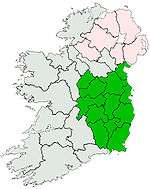Killiney Hill


Killiney Hill (Irish: Cnoc Chill Iníon Léinín) is the southernmost of the two hills which form the southern boundary of Dublin Bay (the other being Dalkey Hill). Crowned by an obelisk, the hill is 153 metres high and offers beautiful views over the surrounding areas: Dublin to the northwest; the Irish Sea and the mountains of Wales (on a clear day) to the east and southeast; and Bray Head and the Wicklow Mountains to the south. The hill was higher in the past but material was removed from the summit for the construction of the pier at Dún Laoghaire.[1]
Killiney Hill stands in the former townland of Mount Mapas, or Scalpwilliam, first mentioned under that name in the beginning of the 17th century. Former residents included Captain Edward Maunsell, who served as the High Sheriff of County Dublin in 1755, followed by Colonel the Hon. Henry Loftus, MP for Bannow in County Wexford. Loftus planted the hill and built nearby roads. In 1790 Lord Clonmell lived here and constructed a park which he filled with deer.[2]
Killiney Hill and Dalkey Hill are both part of Killiney Hill Park, a small public park overlooking the villages of Dalkey to the north and Killiney to the west. In 1887 it was dedicated to public use by Prince Albert Victor of Wales, in memory of Queen Victoria's Jubilee, and called Victoria Hill. The park is crossed by various walking tracks, and with its spectacular views in all directions, is a popular destination for walkers and hikers from the surrounding areas.
References
- ↑ Wright, G. N. (1822). A Guide to the County of Wicklow. London: Baldwin, Cradock, and Joy. p. 5.
- ↑ Francis Elrington Ball: A History of the County Dublin (1902-1920). Chapter II
External links
Coordinates: 53°16′N 6°07′W / 53.267°N 6.117°W
-

Killiney Hill 22 May 2009
